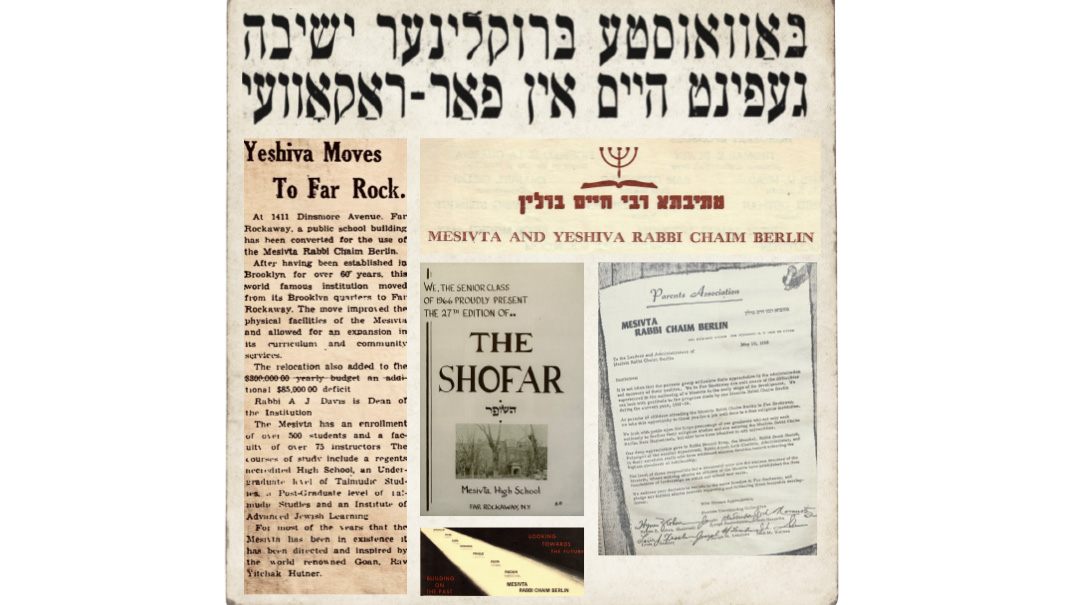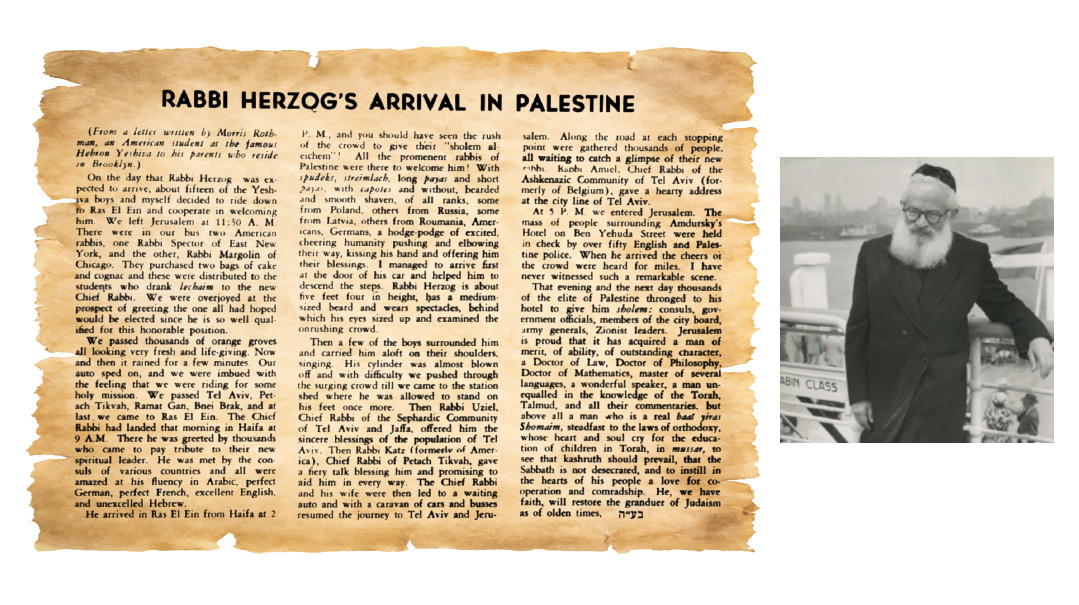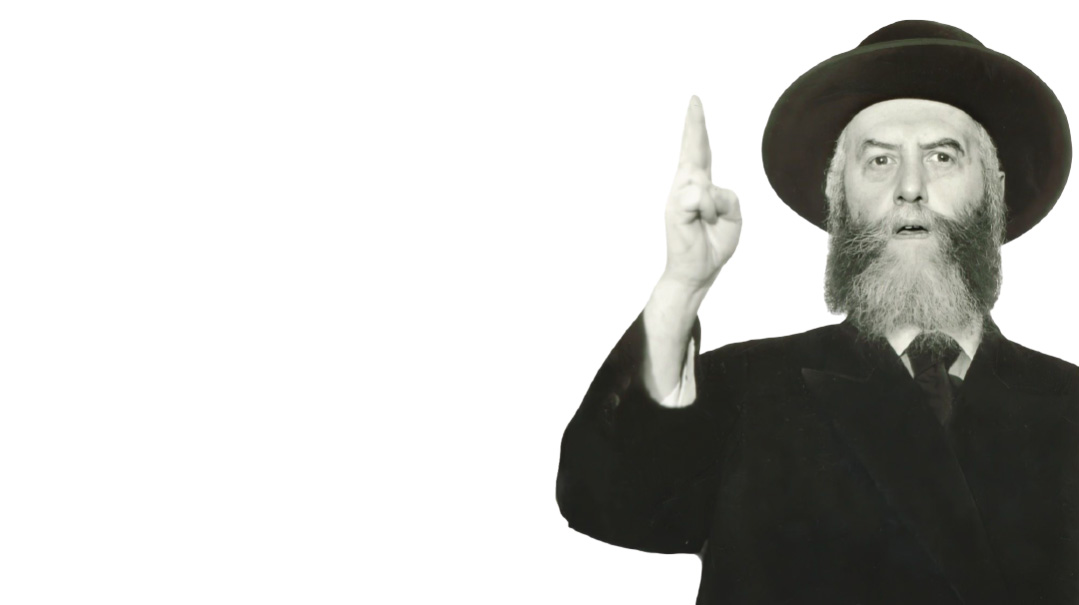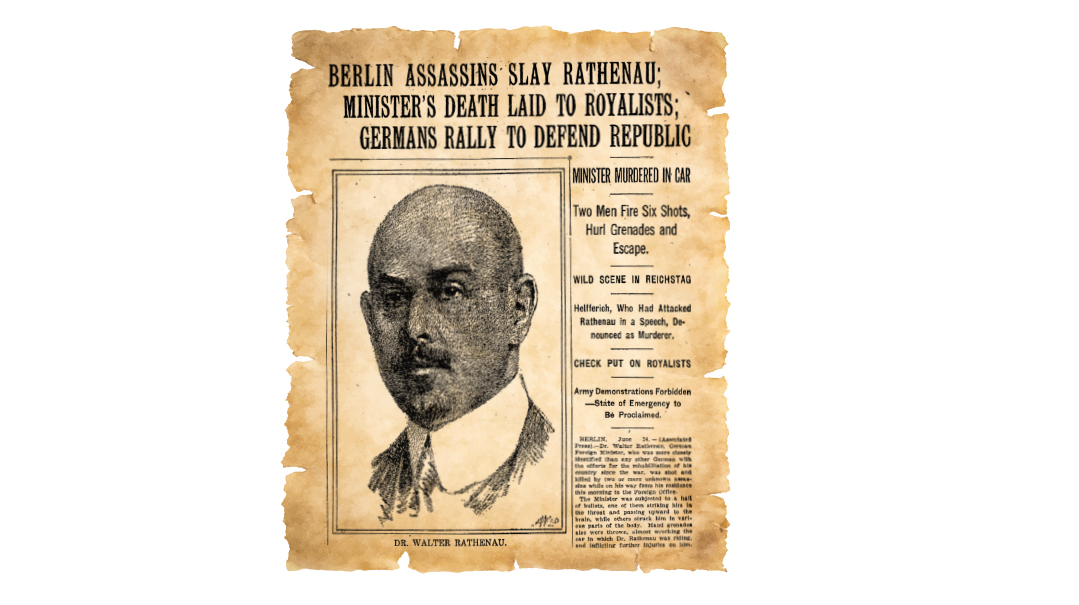Far Away in Far Rockaway
| September 26, 2023Mesivta Rav Chaim Berlin was founded in the early ’30s by the rising star in the yeshivah world, Rav Yitzchok Hutner

Chaim Berlin's short sojourn to Far Rockaway paved the way for the birth of Yeshiva Shor Yoshuv, which continues to thrive more than a half-century after its founding
Title: Far Away in Far Rockaway
Location: Far Rockaway, NY
Document: Collage
Time: 1965
The letters and numbers “P.S. 39” and “1893” are still carved into the bricks and plaster of the old building on Dinsmore Avenue. However, under the old, half-faded letters and numbers, today hangs a new, white sign with bold black lettering — “Mesivta Rabbeinu Chaim Berlin.” The old, outdated building that was abandoned by New York City is today Mesivta Rabbeinu Chaim Berlin. The crown institution of once-Jewish Brownsville was only too happy to embrace and elevate this building, in keeping with an explanation of the pasuk, “He raises the needy from the dust.”
Mesivta Rav Chaim Berlin was founded in the early ’30s by the rising star in the yeshivah world, Rav Yitzchok Hutner of Warsaw and Slabodka, as an addition to Yeshivas Chaim Berlin of Prospect Place in Brownsville, which had been founded in 1899. The changing demographics of Brownsville created a crisis for its Jewish community. Against that backdrop, the old public school building in Far Rockaway was a gift from Heaven.
Both Yeshivas Chaim Berlin and Mesivta Chaim Berlin were forced to leave Brownsville. The boarded-up shell of the yeshivah building on Prospect Place reminds every passerby of the glorious past of the old Brownsville and of the Mesivta building on Stone and Pitkin. The old Municipal Bank has also been demolished to make place for the new residents of Brownsville. The yeshivah found a home on Winthrop Street in the East Flatbush neighborhood of Brooklyn, where it recently built another building. However, the Mesivta chose to go to Far Rockaway until their newly planned home on Kings Highway would be built.
—Nison Gordon, Der Tog Morgen Zhurnal, December 9, 1965
Between the 1880s and 1950s, the Brooklyn neighborhood of Brownsville was the most densely populated Jewish neighborhood in the United States, perhaps in the world. With over 70 shuls and a population that was more than 80 percent Jewish, it earned the moniker “Little Jerusalem.” Some street names followed a Jewish theme. The neighborhood had a vibrant religious life but exhibited a certain diversity; it was home to Jewish organized crime figures, and many working-class residents were prominent in labor unions and the Socialist Party.
Yeshivah and Mesivta Rabbi Chaim Berlin was the centerpiece of Jewish life and a source of pride in the neighborhood. Founded in 1904 as an elementary school, it was the first yeshivah in Brooklyn, and later one of the first high schools as well. A talmid of the Chofetz Chaim, Rav Yaakov Moshe Shurkin, served as its first rosh yeshivah. In the mid-1930s, Rav Yitzchok Hutner was hired as a rebbi in Chaim Berlin, and soon he developed the post–high school yeshivah and served as its rosh yeshivah.
In the 1950s, Brownsville entered a period of demographic transition as Jews began moving out to other Brooklyn neighborhoods and the suburbs. By the mid-1960s, Chaim Berlin found itself isolated in the formerly Jewish neighborhood. The time had come for Chaim Berlin to move on as well, and a property was duly purchased in the emerging Jewish neighborhood of Flatbush on Coney Island Avenue. As plans for constructing a permanent building got underway, Mesivta Rabbi Chaim Berlin temporarily moved to Far Rockaway, remaining there for about five years between 1964 and 1969.
The legendary Yiddish journalist Nison Gordon of Der Tog Morgen Zhurnal colorfully described the yeshivah’s acclimation into Far Rockaway, its development there, and the financial struggles it endured during the transition period:
An “upper-class’’ of Orthodox balabatim live in Far Rockaway, as well as a significant number of Orthodox professionals. Until the arrival of the Mesivta Chaim Berlin, it was the home of the only mesivta high school on Long Island (HILI Yeshivah). Recently, a new girls’ school was also established to address the needs of the parents who do not want co-ed classes. Even more recently, a new Young Israel shul opened, joining the two large Orthodox shuls in the neighborhood, Shaaray Tefila, led by Rabbi Emmanuel Rackman, and the “White Shul” (Knesseth Israel), led by Rabbi Raphael Pelcovitz.
There is also a chassidishe rebbe, the Sulitzer Rebbe, Rav Shmuel Shmelke Rubin; not to mention the community mikvah built a few years ago. In short, Far Rockaway is a neighborhood pleasing to Hashem and to people.…
While we were speaking, the telephone rings and after the first “hello,” Rabbi Avraham Davis [later a prolific author and translator for ArtScroll] begins to stroke the ends of his jet-black beard. One can hear fragments of a conversation: “But Rav Aharon, they can’t do it, the checks are ready, they just need to be signed!
“Tell Mr. Lasker that he should persuade the teachers to stay in the classrooms, tell him that for the first time since coming to Far Rockaway, we have a board with a chairman, Arthur Federman. They just opened a new account at the bank and signed surety for a loan. Tomorrow evening, Mr. Federman will come to the office and sign the checks…”
”Rav Aharon” is Rav Aharon Schechter, the Rosh Yeshivah, who has a Beis Hamedrash of the approximately sixty bochurim of Mesivta Chaim Berlin that remained in Brooklyn and which is temporarily housed in the Kollel Gur Aryeh on President Street in Crown Heights. The Kollel is an extension of Mesivta Rav Chaim Berlin and was founded and is under the personal leadership of Rav Hutner.
The American-born Rav Aharon Schechter, the author of a work on Seder Kodashim, was calling Rabbi Davis to let him know that the English teachers of the Mesivta high school were on strike because it was now more than two months since they had received a paycheck.
A teachers’ strike was unfortunately all too common in yeshivos in the ’60s. While today it’s hard to imagine, back then there was hardly a yeshivah that didn’t have to deal with some sort of labor dispute. In this case it was the teachers striking; at other times, it was rebbeim, who had no choice but to strike in order to receive their wages, which were often more than six months behind.
Upstairs, in the Beis Hamedrash, which had once been the assembly hall of the school, one saw no sign of the crisis that had occurred in the office downstairs. Young bochurim sat with their Gemaras learning enthusiastically. The Rosh Yeshivah of the Beis Hamedrash, Rav Feivel Cohen, sat at a small table and debated with a young bochur who had posed a strong question. …
In a classroom next to the Beis Hamedrash, the new Mashgiach Ruchni of the Mesivta, Rav Shlomo Freifeld, stood in front of a class of young bochurim and held forth in his usual fiery manner with his entire being. Perhaps Rav Freifeld indeed understood the challenging situation of Mesivta Chaim Berlin in its new surroundings.
From the outset, the Far Rockaway sojourn for Chaim Berlin was meant to be temporary. The goal was to return to Brooklyn, where a new campus in Flatbush awaited. When Chaim Berlin bid farewell to Far Rockaway in 1969, however, something remained behind that would leave an impact for decades to come.
Yossi Toiv (Country Yossi) recalled:
It was Friday night in Mesivta Rabbi Chaim Berlin. I had followed the yeshivah from Stone Avenue, Brooklyn, to Far Rockaway and was waiting for Minchah to start. I was schmoozing with a few of my friends. We had heard rumors of a new menahel in the yeshivah, when suddenly the tallest, biggest, most impressive-looking rabbi I had ever seen walked into the Beis Medrash.
He seemed to be seven feet tall and built like a professional linebacker, with a full, flowing black beard, black horn-rimmed glasses, topped off by the widest-brimmed black hat I had ever seen!
He looked at us with a smile on his face and a twinkle in his eyes, and said in a deep, rich voice, “Boys, let’s learn some mishnayos.”
So ten guys who were just killing time waiting for davening quickly sat down around the table, and sat mesmerized as Rav Shlomo Freifeld began his shiur. When he ended 20 minutes later, ten souls had been set afire, and would burn brighter forevermore.
A confluence of factors led to Rav Shlomo Freifeld opening a yeshivah of his own in Far Rockaway. Some of the students in Chaim Berlin needed a different type of yeshivah. Some Far Rockaway locals had come to greatly respect Rav Freifeld, one of the closest talmidim of Rav Yitzchok Hutner and the menahel of the relocated Chaim Berlin.
Beyond that, the Vietnam War was in full swing, and many parents now wanted to shelter their children in yeshivah away from the draft. All this necessitated another yeshivah where Rav Freifeld’s talents would shine. With Rav Hutner’s full blessing, Rav Freifeld remained behind when Chaim Berlin left Far Rockaway, and Yeshivah Sh’or Yoshuv was born.
Rav Shlomo Freifeld and his wife, Rebbetzin Sarah, had an impact that was felt well beyond the walls of his yeshivah. A community grew up around Sh’or Yoshuv that transformed the neighborhood. Thus, Chaim Berlin’s temporary stay left a permanent mark on the Far Rockaway Torah community.

Ropschitz in the Rockaways
A direct descendant of Rav Naftali Horowitz of Ropschitz, Rav Shmuel Shmelke Rubin, the Sulitzer Rebbe (1925–2013), arrived in the United States after the Holocaust. His father had established a branch of the Ropschitz dynasty in Sulitz, Romania. After losing his parents in the Holocaust, Rav Shmuel Shmelke was encouraged by the Satmar Rav to rebuild. He relocated to Far Rockaway, where he faced remarkable challenges in establishing a chassidic community.
His son Rav Yankel, the current Sulitzer Rebbe, stated that his father never ate beef in America, limiting himself to chicken whose entire production was overseen by him or a close family member. However, he didn’ t impose these stringencies on others. It didn’t take long for him to get acclimated to the neighborhood and gain a small but devoted group of followers.
The Sulitzer Rebbe built a kehillah known for its warmth, attracting Jews of all stripes, building a shul that was open to everyone, with shiurim, beautiful davening, and legendary hachnassas orchim, which thrives today under the current Rebbe.
Architect of a Community
Born in 1921 to immigrant parents, Raphael Pelcovitz was raised in Bridgeport, Connecticut, where his father, Slabodka talmid Rav Efraim Pelcovitz, served as rabbi. When Raphael was all of 12 years old, he was sent to Eretz Yisrael, where he studied for four years in Yeshivah Tiferes Tzvi, a preparatory school for the esteemed Chevron Yeshivah.
When the Great Arab Revolt broke out in 1936, he returned to America, continuing his studies at Torah Vodaath and enjoying close relationships with Rav Shlomo Heiman and Rav Shraga Feivel Mendlowitz. After receiving semichah, he served in rabbinical positions in Saratoga Springs, New York, and Akron, Ohio, before assuming the pulpit of the Knesseth Israel shul (the White Shul) in Far Rockaway in 1951.
In his more than half a century at the helm of the shul and community, Rabbi Pelcovitz played a central role in building the Torah community of Far Rockaway. Through his expansion of the White Shul, investment in youth and adult education, building educational institutions and the community mikveh, expanding the Chevra Kaddisha, creating a kashrus infrastructure, and many other endeavors, Rabbi Pelcovitz left an indelible mark on Far Rockaway until his passing at age 97 in 2018.
(Originally featured in Mishpacha, Issue 980)
Oops! We could not locate your form.






